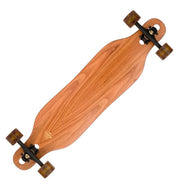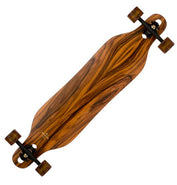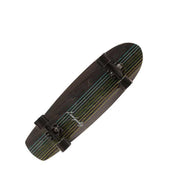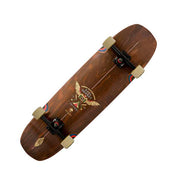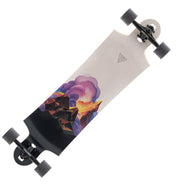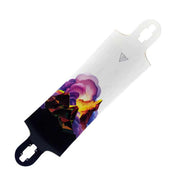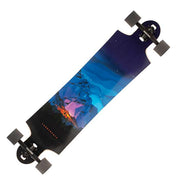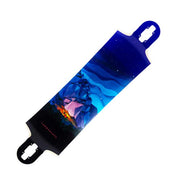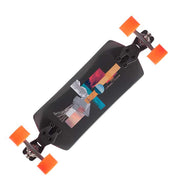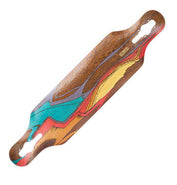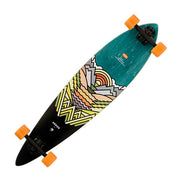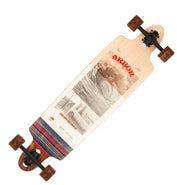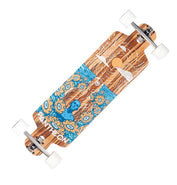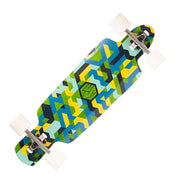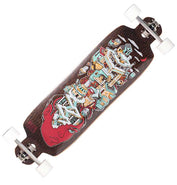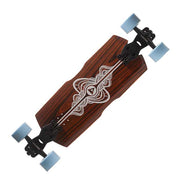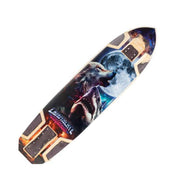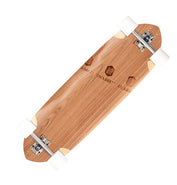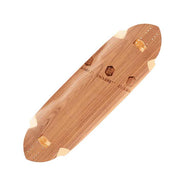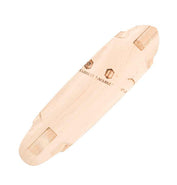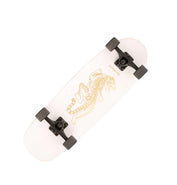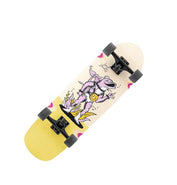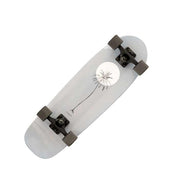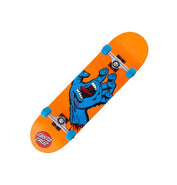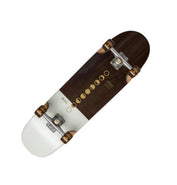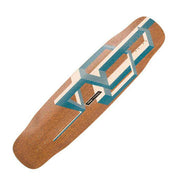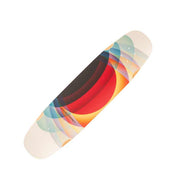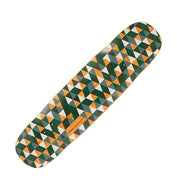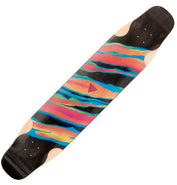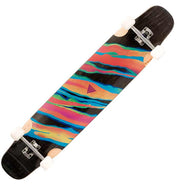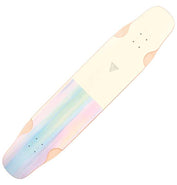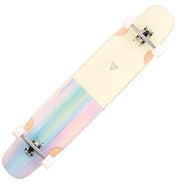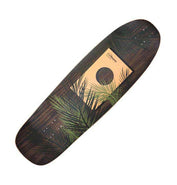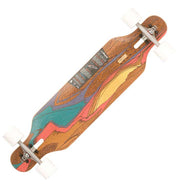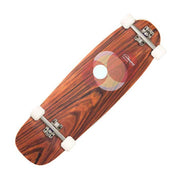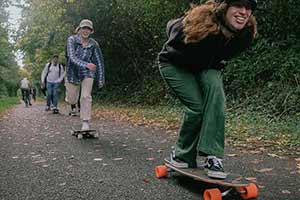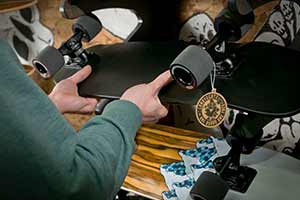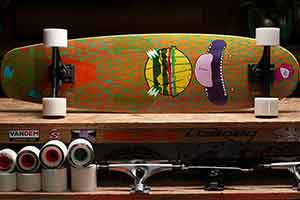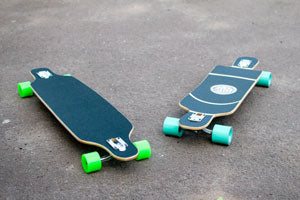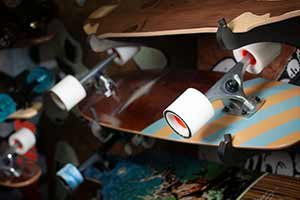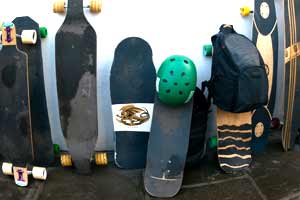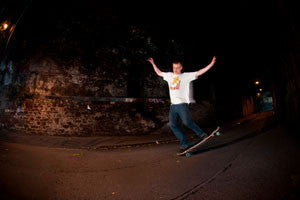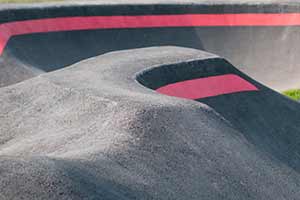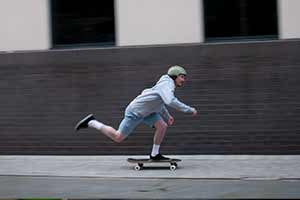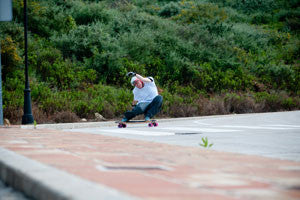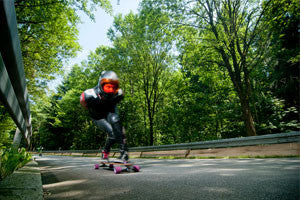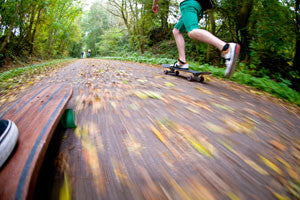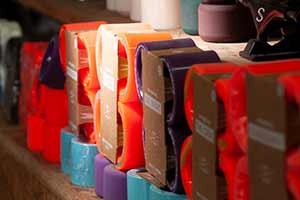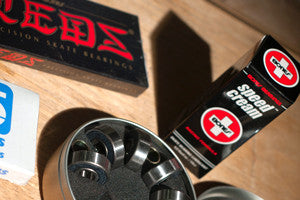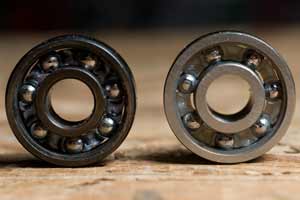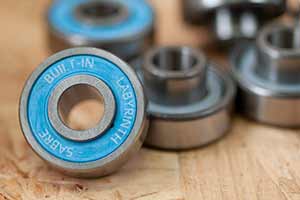Cruiser & Longboard Dictionary
There are many terms used across our site, and indeed the internet, that relate to skateboards, longboards and cruisers that you might feel you are expected to know.
Just in case some of them aren't super clear, we've collected them up here and done our best to explain.
We've laid this out by category, rather than alphabetically. Use CTRL+F if you're searching for a specific term, and if there's anything we've missed, feel free to get in touch!
- What is an adjustable wheelbase?
- Whats the nose and what does it do?
- Whats the tail and what's it good for?
- What does flex mean?
- What are flexy boards good for?
- When do you need a stiff board?
- What does race stiff mean?
- What is pop?
- What are different features of a longboard's profile?
- What's a double kick?
- What is longboard rocker?
- What are 3D features on a longboard?
- What is longboard camber?
- What about a flat longboard?
- What is a kicktail?
- What is a drop down longboard?
- What is a microdrop good for?
- What are the different types of truck mounting?
- What is concave and what does it do?
- What types of longboard construction are there?
- Why are most boards made of maple?
- Are some longboards made of bamboo?
- Is it good to have fibreglass in a longboard?
- What are wheel wells?
What is an adjustable wheelbase?
Much as the name suggests, adjustable wheelbase means that multiple holes are drilled and you are free to choose which to use.
Longer wheelbases will be more stable and flowy, shorter will be grippier and have a tighter turning radius.
At the nose, you might move your truck as far forward as possible to have the longest wheelbase available - on the other hand, moving it back would allow your front foot to be right on top of it for the most direct turning feeling possible.
At the tail, you could again make the choice based on the stability you are looking for, or to get the angle right for precisely balanced manuals and a good pop for ollies.
Seen here, the Hackbrett Semmel allows for almost 4 inches (10cm) of wheelbase adjustment - from scary-squirly to super-stable.

Whats the nose and what does it do?
The nose is the distance from the front truck drilling to the front of the board.
On a regular street skateboard or "popsicle" this is curved steeply upwards from the deck. If the graphic isn't showing you which way is forwards, you can work it out knowing that the nose is usually steeper and wider than the tail. Having a steep nose is best if you want to learn to kickflip, but ollies and tricks are more than possible with a flat nose too!
On a cruiser or longboard it's more likely that the nose will be flat. This gives extra room for the trucks to be mounted further forwards for more stability and a bigger standing platform in general. Dancing and freestyle longboards often have a larger nose for manuals, shuv-its and flips, whereas for a downhill board a nose is mostly unnecessary.
Though not strictly necessary, having a steep nose on a popsicle or old school deck makes it easier to level out your ollies. Throw in 20 years of practise and maybe you'll be able to do them like Darren here!

Whats the tail and what's it good for?
The tail is the space from the rearmost truck drilling to the back of the board.
A kicktail is a tail that curves upwards from the deck and is great for tricks and agility round town - it will allow you to kickturn, de-weight to drop off kerbs, jump over small children, etc. These things are possible without a kicktail but that's getting more specialist.
What you want to do with your board will dictate whether a tail is necessary. Tricks round town? Yes. Carving or bombing down smooth hills? Less so, however if you've got to skate to the bus stop first it could be useful.
As seen on the right here, most cruisers will have a tail to allow you to be as agile as possible in an urban environment. Even if you aren't into ollies, simply being able to de-weight your front trucks can make rolling over cracks or drains a lot easier, not to mention being able to tic-tac and kickturn around sharp pathway corners!

What does flex mean?
How flexy (or stiff, or bouncy, or saggy) your board is. Dictated mostly by the boards construction - for example, a fibreglass layer will stiffen up a board - but things like the wheelbase, concave and profile will also impact a boards flex.
How much flex you want will depend partly on what you're doing with your board, and partly on personal preference. Torsional flex (twisting) is certainly unwanted. Longitudinal flex has its place and a bit of dampening is nice.
At one time there was a 100% carbon board available for pushing long distances. It was so stiff that the road vibration gave users "white foot" as all the blood jiggled back up their legs. Crazy. Needless to say, 100% stiff boards are not super comfortable.
We generally say boards are flexy, stiff, race stiff or have pop.
What are flexy boards good for?
Boing boing... flex can be pretty nice on a cruiser or a dancer. It adds some spring to your cross-steps and feels good to wiggle back and forth on a deck that returns some of that energy to you.
Jooz (right) shows us a cross step down at Weston-super-Mare on the Lush Legend - featuring a gentle, natural flex.

When do you need a stiff board?
A lot of longboards will fall roughly into this category and for going faster, sliding or getting airbourne, a stiff deck will really help with control. Boards that aren't flexing or bouncing but equally, won't be completely rock solid.
If you're going faster around a corner, you won't have your energy returned to you and put you off your balance, your slides will be less likely to chatter, and landing a trick won't feel like you're landing on a trampoline.
Not a one-trick-pony, Jooz is at it again with a steezy toeside speedcheck. This time with a stiffer board, Sabre Forged Precision trucks and Cult Creator wheels. A high performance setup!

What does race stiff mean?
Aside from a small amount of dampening, a downhill/race board should ideally be stiff - race stiff. This allows your movements to translate as directly as possible into your trucks and wheels with as little energy lost through the deck as possible. You'll have more control for the millimetre precision that's necessary when riding fast and close with friends and enemies.
We got this photo of Alex at the legendary Almabtrieb race in Germany. Hooning into this lefty with 60mph leaves litle room for error! It was pretty exclusively stiff race boards, precision trucks and wide, grippy downhill wheels being used.

What is pop?
Pop is that feeling of slamming your tail down and the board becoming airbourne. Street skateboards are known as popsicles for this reason, and those boards are where pop is most important - tricks are the focus. However, cruisers with tails will also benefit from a good pop, and our old-school range wouldn't be fit for use if it didn't feature plenty of pop too!
Darren knows a thing or two about pop - here he is just up the road from the shop in St Georges park. It's lumpy and bumpy but that doesn't seem to worry him when he's a metre in the air.

What are different features of a longboard's profile?
Profile refers to whats happening along the length of the deck - perpendicular to concave. Boards will have different profile features depending on what they're made for - the most obvious being a kicktail for pop. Longboards have developed other features too that help with other aspects of riding - stability or foot placement for example.
What's a double kick?
The classic skateboard, both ends of the board kick upwards. All modern popsicles feature double kicks, and certain retro shapes as well as freestyle and dancing longboards will do too. This is all about trick ability - popping the board into the air, into your hands, doing flips. Having both a nose and tail means that you always have access to every variation of a trick, no matter which way you're facing or riding.

What is longboard rocker?
Rocker is a curve from the nose through to the tail of the board, like a banana. With rocker, the middle of the board is the bottom of the curve and the highest points are at the ends. It's the opposite to camber. What's it good for?
Rocker provides a lower centre of gravity, thereby making you more stable. It also means that the wood of the deck is already under tension, so it won't flex too much.
Rockered boards, unless they have flat truck seats, will increase the angle of your trucks and make them more turny.
Perhaps the most important thing with rocker is that "locked in" feeling. Just like the concave across the board, a good rocker can be like a cuddle for your feet!
This board here is the Landyachtz Drop Cat - super rockered, double points to Landyachtz for painting it yellow for the real banana vibes.

What are 3D features on a longboard?
3D boards have more going on. Different variations of rocker, drops, W-concave and wheel arches all join together seamlessly to create an comfy ergonomic platform on which you'll always know exactly where your feet are. The aim here is to have turns and slides be drawn in your mind and be translated perfectly through your feet and into the road. This is high-end stuff. Look closely at any boards labelled as 3D, they aren't all the same but we try and get the differences across in our descriptions and photography.

What is longboard camber?
The opposite of rocker, camber is having a board with a banana curve from nose to tail but this time the middle of the board is the highest point. Boards with camber have a lively flex that works great for pumping and carving around town. You push down into carves and your board will push back up as you straighten out. Feels really good!
Pictured here is the Loaded Icarus - meaty camber that makes for a lively board that lives up to the name of "Loaded Carving Systems".

What about a flat longboard?
Just like it says on the tin... flat boards don't have anything happening (at least from nose to tail - they will likely still have concave!). That's not a bad thing - most pintail longboards are totally flat, and nothing else is necessary to enjoy a good cruise along the promenade or down some gentle slopes. Without any 3D features, flat boards are about as comfy as it gets for a day out with the wind in your hair.
On the right here we've got the Lush Mako - a comfy concave and a flat profile for your classic longboard feeling.

What is a kicktail?
A tail that curves upwards. With a kicktail you can do manuals (wheelies), ollies and generally be more nimble as you cruise your way around town. It can be as simple as weighting the tail to make a tight radius turn around a corner, lifting up your front wheels as you drop off a kerb or being able to pop your board up into your hand to run up some stairs. However you use it, a kicktail makes an urban environment more accessible and fun to skate.
Boards designated as having a kicktail just have the single kick at the back as opposed to a double kick.
The tail showing here on the right is that of the Lush Throttle - a short longboard that is comfortable both round town and on the hills. Seen here with Cult Chronicles, Sabre Standard trucks and Sabre Labyrinth Built-in bearings.

What is a drop down longboard?
Dropdown boards have a standing platform lower than where the trucks are mounted. Why would you want to be lower?
A lower centre of gravity is inherently more stable. It's also less distance from the ground to the board, so pushing and footbraking require less effort. Dropdown boards are designed often for "long distance" skateboarding - saving a small amount of energy on each push makes a real difference when the mileage increases. You don't have to push hundreds of miles to feel the difference, though. If you have a smooth path in front of you and aren't interested in anything but cruising along and carving then a dropdown board is one of the best options.
Dropdown boards have also been popular among the downhill and sliding/freeride contingent. Being lower is more stable at speed and allows you to get sliding easier too - your weight being alongside the wheels rather than above them. This means that dropdown boards feel quite surfy - less grippy - than a topmount.
The tasty drop you can see here is on the Loaded x Pantheon Trip. Being both drop-through and drop down ("double drop"), this board is as low as it gets! Pushing around doesn't get easier than this.

What is a microdrop good for?
Similar to a dropdown, but this time the drop is far less pronounced. Micro, you could say.
Boards with a microdrop retain the advantages of a topmount board - great grip levels and direct turn, but with a slightly lowered ride height. This not only helps with stability, but similar to a rocker, gives a real cradle effect to your feet. It's really comfy and you never have to look down to know where your feet are.
The smooth walnutty curves on the right are that of the Hackbrett Schnelle. A downhill machine, hand crafted in the foothills of the Blackforest in Germany. Juicy.

What is a topmount?
The board is mounted, wait for it... on top of the trucks. Picture a skateboard in your mind - it's a topmount.
A topmount has a high ride height. This changes a few things - firstly, it's less stable than something lower. It's all relative and this is absolutely not to say that a beginner can't ride one. In fact, most people who rode a board will have started on a topmount.
Secondly, your weight is on top of your trucks and wheels. Being right on top gives you the best leverage over your truck, and therefore the most direct control over your turn. It's more responsive and will allow you to create a tighter radius carve than a lowered deck.
Being on top of your wheels means your weight is pushing them down into the ground - topmounts have the best grip levels.
Topmounts can also have noses and tails, so if you're looking to ollie or do any trickery then this is the one.

What is a drop-through longboard?
A drop through deck has the trucks mounted through the deck itself. You'll be able to see the top of your baseplate through your board - which has a big hole in it to allow for the drop through mounting.
The main function of this is the ride height - it's lower than a topmount. Everything you read about a topmount above, the reverse is true here:
A lower centre of gravity means you're more stable - especially noticable as your speed increases. If you are a beginner and are worried about stability, consider a drop through to flatten out the initial learning curve.
Your weight is not on top of the trucks and wheels but more level with them. You have less leverage over your trucks and so they won't be as twitchy, and won't respond as fast to shifts in weight.
This also means that it'll be easier to push your wheels out of traction, into a slide. That can be a good or a bad thing, depending on what you're after! It will feel a bit more snowboardy in the way the back might drift out of carves.
Being lower to the ground also means that you have to bend less to push or footbrake. Drop throughs are therefore great for anyone looking to push a longer distance or commute (providing you don't have to go up and down too many kerbs along the way).
Drop through shapes generally have large cutouts to avoid wheelbite. This makes it difficult to have much of a nose and tail, so regular skateboard tricks are not the focus here.

What are flat truck seats?
Also known as flush mounts. Flat truck seats are available in some topmount boards that feature microdrops or other 3D concave finery and are usually CNC milled into the deck. This allows your trucks to sit evenly and be properly attached to the board, rather than having any gaps or unwanted mounting angle due to the 3D nature of the deck.
The Hackbrett Krokodil, shown here, has a microdrop and a CNC'd flushcut underneath to keep the trucks seated evenly. This allows the trucks to be mounted right underneath the drop, exactly where your front foot is, for the most direct turning possible.

What is street concave?
Street concave is found on...wait for it... street skateboards!
It's generally going to feel a little more aggressive than a pool concave, partly due to the deck itself being narrower.
Whereas with a cruiser or a longboard the concave is all about getting that "locked in" feeling on the edges, on a street deck the concave is going to be used mostly for flipping the board. Decks will come in low, medium or high concave, though these won't be the same from brand to brand.
On the right here is a Landyachtz Dinghy - a cruiserboard with a street concave, that makes for a really functional machine. From powerslides to ollies and flip tricks, this is a cruiser board that will do it all. Cruising included.
Here at Vandem we don't have too many classic street options, so you won't see much street concave about. We tend to go for the wider and less aggressive pool shapes that are well suited to tricks, transition and cruising as well. You'll never guess what concave they have...

What is pool concave?
Pool concave, a mellowed out version of a street concave to fit the wider pool boards of 9", 10".
With fatter boards, flip tricks are not the focus so the concave can be lower and more comfy. There's still got to be enough to keep you locked in as you slash around the bowl, though, which makes these boards perfect for cruising too.
Pool cancave is simple and radial, but it does differ from board to board and brand to brand. You may also see something called the "Cruz Missile II" concave which is definitely a pool concave but is also something special by itself. We like it. You can read about it here.
Pictured here is the Lush Dagyr pool shape - a great example of a pool concave on a 9.25" deck that works for slashing round the skatepark, pumptrack and urban commute too.

What is deep concave?
Boards marked as having deep concave have more of a curvature and a focus on keeping your feet absolutely locked into the board. Generally this is for slides or downhill riding where control is paramount.
On the right here is the Hackbrett Semmel - note how the concave is flatter in the middle and kicks up in 2 stages to give a comfortable platform in the middle but a huge amount of hold on the rails. This is a concave thats been taken down world cup race tracks the world over!
Deep concave can be really comfy when done well - and we only keep the good stuff in stock! However, it's generally not the concave you want to go for if you are planning to spend all day cruising about on your board through the city. For that, read on...

What is mild concave?
Home sweet comfy home, mild concave!
Most boards will be classed as mild. It's the perfect middle ground. Too flat and you'll start to lose the feeling of the edge of your board, too steep and it'll start to ache your feet as you push and cruise around. Mild is that nice in between that your toes can really find as you turn, but that you don't even notice under your feet over the day.
If it's a really good one it'll feel comfy to sit on for an after-skate beer, too!
Pictured is the Lush Fuel - a mild concave for comfy cruising.

What types of longboard construction are there?
What your board's made of! Skateboards are traditionally made of Canadian maple but the longboard and cruiser market has vastly expanded the horizons in terms of board construction. Sustainability is being taken into account by more and more board manufacturers, and the high-end is very technical with the materials, core layups and ideas they are bringing to the table. The basics can be found below...
Why are most boards made of maple?
The classic skateboard material. It's a wood that ranks super high when you consider three key points: strength, weight and price. Skateboards and longboards are made of slower growth maple from northern regions. The slow growth makes for a much tighter grain and stronger ply than maple grown in Europe, for example, which grows faster in the warmer climate and is noticably more flimsy.
Skateboards are usually 7 plies of maple. At a regular skateboard length and wheelbase, this makes for a stiff board with good pop and many cruisers will share this construction.
The longer wheelbases of longboards means that 7 plies of maple will feel more flexy, and it's not uncommon for a longboard to have 8 or more plies, or layers of different woods or composite materials involved to ensure a strong enough deck with the desired flex characteristics.
Landyachtz Longboards is a Canadian brand that naturally uses a lot of maple in their boards. The crisp clean look of the thin plies sandwiched together will be familiar for anyone who's spent much time around skateboards.

Are some longboards made of bamboo?
Bamboo can be grown sustainably - it grows fast, requires no fertiliser and doesn't even need replanting - it regenerates from it's own roots. Pandas really like it, too.
As for board construction, some cruising brands like Loaded are synonymous with bamboo. It's often used to create a lively flex for pumping and carving. That's not to say bamboo boards have to be flexy, though. Different layups and including composites can create a board that feels stiff and responsive, more like the maple we are used to feeling under our feet.

Is it good to have fibreglass in a longboard?
Fibreglass can be used in both skateboards and longboards to increase pop and decrease weight when compared to adding more wood.
A layer of fibreglass will also be used to decrease torsional flex, especially in longboards. Manufacturers will go as far as using different weight cloth in different boards to always get them feeling exactly as planned. Where drop through boards have narrow necks due to the cutouts, fibreglass will also reinforce that weak point.
In the board to the right - a Hackbrett Schnelle - the darker lines between the plies are the fibreglass layers. The weight and amount of glass changes in each board depending on the exact characteristics they are looking for, and works together with the concave and profile to create flex patterns (or stiffness).

What are CNC wheel wells?
Using a CNC (computer numerically controlled) machine to mill wheel wells offers a board builder complete control over the location, shape and depth of the wheel wells. It means that they'll be consistently perfect and in exactly the right spot - often elongated for adjustable wheelbases or different truck angles too. Deck manufacturers going to this length are really paying attention!
The wheel wells on this Hackbrett Semmel are CNC milled and then hand sanded to achieve a functional wheel well with a super smooth finish.

What are sanded wheel wells?
Sanded wheel wells are sanded into a deck using an orbital or drum sander. This will generally be done using a jig to ensure the placement and depth of the wheelwells are consistent. They may be a bit smaller than CNC wheel wells but they'll give you those all important extra few millimetres to lean into your turn without getting ejected by wheelbite.
The Nomad Surf cruiser isn't designed to take massive wheels, so these sanded wheel wells are more than enough to give you the extra clearance necessary to fully lean into your turns.

What are moulded wheel wells?
Otherwise known as wheel arches. The deck itself is pressed with arches over the wheels, like additional concave. This can be instead of, or as well as, regular wheel wells. Often used for more high-end spec boards for sliding or downhill, it has the added benefit of being an extra feature for your feet to grip onto and know where they are on the deck.
The big arches on the right are a feature of the Loaded Omakase. It was originally designed as an electric board and the wheel arches allow for a bigger wheel. The electric thing didn't really take off as planned, but the Omakase lives on as it's an awesome cruiser in its own right.

What are cut outs on a longboard?
With cutouts, the outline of the deck itself is narrowed to allow extra space for the wheels. This is mostly seen on drop-through or drop-down boards where the wheels are really close to the deck. This type of board excels at pushing, cruising, carving and downhill stability but is less practical for flips and tricks.

Now you know the lingo... how do you decide which board you want?
Maybe you've got some ideas from this page - a kicktail for tricks or a long wheelbase for the flowiest carves going? There's a lot to choose from, and even once you've narrowed it down there are still multiple widths and lengths available. For more info on the intricacies of why board size matters, check out our explainer video!


